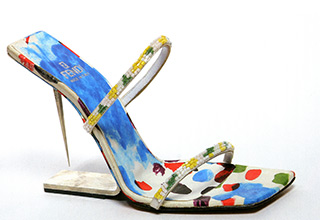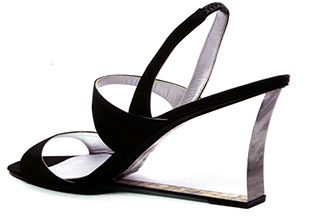The Meaning Of Shoes
A book extract from Professor Giorgio Riello, Global History and Culture Centre
Published September 2012

Footwear is more than a simple wrapping or protection for the foot. The notion that shoes indicate a great deal about a person’s taste (or disdain for such things) and identity – national, regional, professional – class status and gender, is not an invention of modernity. Shoes have, for centuries, given hints about a person’s character, social and cultural place, even sexual preference.1 Shoes are powerful “things”, as they take control over the physical and human space in which we live. They allow us to move in and experience the environment. They are the principle intersection between body and physical space. The psychologist Nicola Squicciarino has called this “extensions on the corporeal ego.” Shoes, then, are always more than simple garments allowing us to walk, stroll and run on streets, parks and fields. They are tools that amplify our bodies’ capacities. Everyday shoes allow us to walk to work, to run for the bus, to look smart at a party. High-tech shoes have permitted the demonstrable improvement of the world record for the 100 meters during the last hundred years (in conjunction with training and nutritional regimes). Shoes thus extend our social and emotional capacities, as well as our physical capacity.2
Navigating the ground and one “edge” of the body i.e. the foot, footwear acquires different meanings related to sex, attractiveness, group membership and power.3 Such meanings appear in different ways through time from ancient Greece to premodern Japan and present-day Western societies. A case in point is the theme of identity, be it personal or collective. To wear white sneakers in present-day northern Europe is a signifier of a membership of a specific type of youth culture: “trainers,” kept rigorously white and spotless, are used by working-class youngsters. This means resorting to blacking and painting. An unexpected parallelism can be demonstrated in late eighteenth-century Europe, where the bleaching of boots was part of the ritual of a gentleman’s behaviour.

These social rituals related to the wearing of footwear are apparent in different cultures over time, although they take myriad forms. In many instances, social rituals can assume religious connotations, as in the case of pre-modern Japan, where shoes were, on the one hand, polluting agents but also at the center stage of rituals of purification. In other societies, it is religious and moral values that shape footwear. In medieval Europe, for instance, moral precepts formulated from the Bible were used to limit the height of shoes and the wearing of footwear made of luxurious materials such as silk, embroidery and pearls. A tension is present, throughout history, between the power of shoes as tools of self-presentation and their persistent sociocultural nature. On the one hand, shoes are very personal garments. A pair of red stiletto shoes is quite different, in every way, from a pair of boots. An attractive young lady can decide that her ankles look better in stilettos than in boots. But her choice is rather more sympathetic for a smart party than a rock concert. The issue of the appropriateness of shoes reminds us that they must always adapt not only to the physical terrain but also to the social one.
Shoes differ not only according to their use, but also according to their wearer. Several chapters in this volume touch on the fact that shoes are used not only to differentiate between the sexes but also as tools in gender relations. The smallness of women’s feet, for instance, is a feature emphasized by many cultures over time. If the most classic example is premodern China, where women’s feet were bound to limit their growth, the use of small shoes was also common in eighteenth- and nineteenth-century Europe. The smallness of the foot made walking more sinuous, but also more difficult. It clearly inferred that feet were organs of locomotion for men, but part of the sensual appeal of women4. A man’s boot, however, in creating the sense of the extension of calf and encasing the lower leg in glistening leather, was just as erotic as any slipper worn by a woman. Several chapters in this book thus consider the act of walking in a socially defined space. Mobility within space is in part connected to the nature and quality of shoes. But it would be a mistake to think that this relationship is just about the physical.5 As previous writers have demonstrated, the role of the shoe in slave and other enslaved communities, such as the prisoners of the Nazis, was central to their ability to survive, escape, and stay alive.6 If women in society encountered barriers against free movement, such barriers often had little to do with real bodily limits. The limits were social, and shoes played their role in constructing and reinscribing these roles.
1 Bilger, Burkham, 'Sole Survivor. One Man's Quest to Find the Best Shoes Ever Made,' The New Yorker, February 14-21, 2005, pp. 152-167.
2 Wendy Parkins suggests that "dress is a situated bodily practice." Parkins, Wendy, 'Introduction' in Wendy Parkins (ed.), Fashioning the Body Politic, Oxford and New York, Berg, 2002, pp. 1-18.
3Johnson, Kim K. P. and Shannon J. Lennon, 'Introduction: Appeareance and Social Power,' in Kim K.P. Johnson and Shannon J. Lennon (eds), Appearance and Power, Oxford and New York, Berg, 1999, pp. 1-10 and Barnes, Ruth and Joanne B. Eicher, 'Introduction' in Ruth Barnes and Joanne B. Eicher (eds) Dress and Gender: Making and Meaning in Cultural Contexts, Oxford, Berg, 1993, pp. 1-7.
4 Perkins Gilman, Charlotte The Dress of Women. A Critical Introduction to Symbolism and Sociology of Clothing, Westport, CT, Greenwood Press, 2002
5 Solnit, Rebecca, Wanderlust: A History of Walking, New York, Viking, 2000.
6 Jones, Ellen Carol, 'Empty Shoes' in Shari Benstock and Suzanne Ferriss (eds), Footnotes: On Shoes, New Brunswick, NJ and London, Rutgers University Press, 2001, pp. 197-232.
 Professor Giorgio Riello, Associate Professor in Global History and Culture (Department of History) has written extensively on early modern textiles, dress and fashion, and material culture in Europe and Asia. He is the author of A Foot in the Past: Consumers, Producers and Footwear in the Long Eighteenth Century (2006) and has co-edited four volumes including (with Peter McNeil), Shoes: A History from Sandals to Sneakers (2006). He is the Newcomen Article Prize Winner 2009 for the article 'Strategies and Boundaries' and is Director of the Pasold Research Fund.
Professor Giorgio Riello, Associate Professor in Global History and Culture (Department of History) has written extensively on early modern textiles, dress and fashion, and material culture in Europe and Asia. He is the author of A Foot in the Past: Consumers, Producers and Footwear in the Long Eighteenth Century (2006) and has co-edited four volumes including (with Peter McNeil), Shoes: A History from Sandals to Sneakers (2006). He is the Newcomen Article Prize Winner 2009 for the article 'Strategies and Boundaries' and is Director of the Pasold Research Fund.
Extract published with kind permission of Bloomsbury Publishing Plc.
© Riello, Giorgio and Peter McNeil Shoes: A History from Sandals to Sneakers, 2006, Berg, Bloomsbury Publishing Plc.
Image (top): Sandal with suspended heel, designed by Karl Langerfeld for Fendi, 1990s. Museo Rossimoda, Stra, Venice.
Image (bottom): Platform shoe made of plexiglass by Rossimoda for Anne Klein, 1990s. Museo Rossimoda, Stra, Venice.
